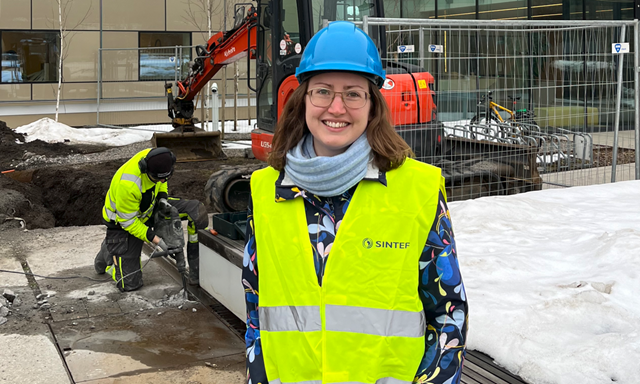The development of zero-emission areas (ZEAs) in our future towns and cities is a key aim. This means that greenhouse gas emissions must be reduced. Researchers at the FME ZEN (Research Centre for Zero-Emission Neighbourhoods in Smart Cities) have been working towards this goal for almost eight years. They have now published their final report called ‘Insights into ZEN pilot projects: An overview and experience summary’.
The airport that became a ‘test pilot’
“Our pilot projects serve as ZEA test sites”, explains SINTEF researcher Marianne Kjendseth Wiik, who is a co-author of the report. “Such sites represent innovation hubs, where we test new technologies for construction, operation and utilisation of the ZEAs in question”, she says.
The definition of a zero-emission area is a group of inter-linked buildings with associated infrastructure, situated within a limited geographical area.
The former Oslo airport at Fornebu has been selected by the research team as a ‘test pilot’ site, with the aim of removing all greenhouse gas emissions from the area. Testing is being carried out in collaboration with technical experts, property developers, local municipalities and landowners, energy companies and site users.

Research Scientist Marianne Kjendseth Wiik. Photo: SINTEF
The project is currently running 11 pilot sites. These include three residential areas with public infrastructure (at Zero Village Bergen, Ydalir and Steinkjer), five urban development areas (at Furuset, Sluppen, Nyhavna, Bodø and Fornebu) and three campus sites at NTNU Campus Gløshaugen, Campus Evenstad and the Mære Agricultural College.
These pilot sites exhibit significant differences in terms of areal extent, function, types of building, location and the degrees to which they have progressed in terms of their development.
A modern, but historic suburb
The Fornebu site was nominated as a ZEA by Bærum municipality and includes the area surrounding the old air traffic control tower. This part of the old airport is being developed to encompass several new districts, with schools, health clinics and business parks. Creativity and innovation are key elements of this project.
“The objectives of the ZEN Centre were integrated into our work from the very beginning”, says landscape architect Karen Gunleiksrud, who is project manager for the work being carried out close to the control tower. “This has been key to the choices we made when starting the development of this site”, she says.
Bærum municipality has been a collaborative partner and has offered pilot sites ever since the launch of the ZEN Centre. It sees great value in having access to state-of-the-art technical know-how, as well as relevant input to the discussions and decision-making processes involved in this major urban development project.
Sharing solar power
The first step taken by the municipality towards creating a ZEA at Fornebu was to build the Treklang Centre at Oksenøya. The centre houses a primary school and kindergarten, as well as a community centre and clinic, enabling activities for both young and old to be located on the same site.
A large solar panel array has been installed on many of the centre’s roofs and façades, permitting solar energy to be exchanged between the various buildings. The centre has also made extensive use of green roofs, low-carbon concrete and timber construction. The Oksenøya development is also acting as a pilot facility for a sustainability programme called FutureBuilt, which operates with its own zero-emission building criteria.
“The most difficult aspect of all innovation projects is the timely procurement of new systems”, says Camilla Torp, who is head of sustainability and installation at Bærum Municipality’s Properties Division. “This is because although development proceeds very rapidly, the construction processes take time”, she says.

The area surrounding the old air traffic control tower at Fornebu is being developed as a suburban centre. The aim is to create a lively, multifaceted, green and climate change-adapted suburb offering a variety of community activities. Photo: Judith Thomsen/SINTEF
A school with no parking?
A key objective for achieving zero-emission targets at Fornebu has been to reduce vehicle use to and from the local school and the area as a whole. For this reason, no space was set aside for parking or drop-off zones in front of the school. However, out of consideration for practical logistics and the safety of the buildings’ users, it has been necessary to reinstate drop-off zones, at least temporarily.
“However, we know that we have to take steps to reduce vehicle use if we are to achieve the targets stipulated by the municipality for the Fornebu area”, says Gunleiksrud.
In response to an initiative from the ZEN Centre, the municipality has also approved a municipal development plan (KDP3) that encompasses the entire Fornebu site.
Searching out the biggest emissions
Municipal staff have been working as part of a cross-disciplinary team that incorporated the idea of a ZEA at Fornebu during its very first meeting. Normally, perspectives such as these develop later in the process, by which time it may be too late.
“This is also the first site for which we have carried out greenhouse gas calculations at the high-level planning stage”, says Gunleiksrud. “It’s important to identify the sources of the biggest greenhouse gas emissions so that we can make the best choices during the planning and implementation phases”, she says.
Gunleiksrud goes on to explain that this process has been very beneficial, especially in connection with the heritage buildings in the area of the control tower. For example, the old fire station building was left standing. Such considerations help to retain the site’s identity and links with the past.
High cost of living
Throughout the eight years of operation of the ZEN Centre, social change and market trends have had an impact on its projects. High interest rates and rising costs have presented some challenges. Such developments may serve to reduce stakeholders’ willingness to make commitments, especially in the case of small and medium-sized actors.
“Encouraging acceptance in the market for new technologies by means of clear incentives and financial support is one way of augmenting their use”, says Kjendseth Wiik. “Moreover, inspiration generated by pilot projects can have a significant influence on future markets”, she says.
“Successful initiatives create a precedence for the use of advanced energy technologies as part of urban development”, she continues. “This can inspire similar projects and help to accelerate acceptance in the market”, says Kjendseth Wiik.
However, this requires new business models that offer effective support to innovative technologies.
Reference:
Judith Thomsen, Shabnam Homaei, Anne-Lise Aakervik and Marianne Kjendseth Wiik: ‘Insights into ZEN pilot projects: An overview and experience summary’. Published by SINTEF akademisk forlag.
Key facts:
- The Research Centre for Zero-Emission Neighbourhoods in Smart Cities (FME ZEN) contributes towards a low-emission society by developing technologies that promote zero greenhouse gas emissions from future buildings and developments. This is carried out in collaboration between research scientists, municipalities, industrial companies and government organisations.
- The ZEN Centre’s pilot areas are owned by its business partners (mostly municipalities), although one such area is owned by a private sector property developer. The pilot projects include both new and existing sites selected for upgrading and further development. The Centre’s partners have established the aim of trialling the ZEN concept.
- The Centre currently has nine pilot projects running across Norway. The pilots cover a total area in excess of one million square metres, involving more than 30,000 inhabitants.
- The ZEN Centre operates with a budget of about NOK 380 million and is funded by the Research Council of Norway, its research partners NTNU and SINTEF, as well as ‘user partners’ from the public and private sectors.
- NTNU acts as the host institution and coordinates the Centre’s activities in collaboration with SINTEF. The Centre operates with a project term from 2017 to 2024.




